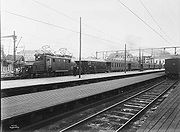
NSB El 1
Encyclopedia
NSB El 1 is the first electric locomotive
series used by Norges Statsbaner, from 1922 until 1973. Twenty-four engines were delivered from ASEA and Thune
, twenty-two in 1922 and two in 1930. Based on the German DB E 71 and Swedish SJ Oc it has two two-axeled bogie
s with one motor in each.
to Brakerøya
was electrified
as the first NSB line in 1922, NSB was in need of electric traction. The engines were used both for passenger- and freight trains. At first it was used on Drammenbanen, then on Sørlandsbanen. In 1966 two of the locos, no. 2001 and 2002, were sold to Rjukanbanen where they served until 1988. Two of the locomotives have been preserved (no. 2001 and 2011).

Electric locomotive
An electric locomotive is a locomotive powered by electricity from overhead lines, a third rail or an on-board energy storage device...
series used by Norges Statsbaner, from 1922 until 1973. Twenty-four engines were delivered from ASEA and Thune
Thune
Thunes Mekaniske Værksted A/S, Thune for short, was a Norwegian manufacturing company that among other things built locomotives. The production facilities were last located at Skøyen.-History:...
, twenty-two in 1922 and two in 1930. Based on the German DB E 71 and Swedish SJ Oc it has two two-axeled bogie
Bogie
A bogie is a wheeled wagon or trolley. In mechanics terms, a bogie is a chassis or framework carrying wheels, attached to a vehicle. It can be fixed in place, as on a cargo truck, mounted on a swivel, as on a railway carriage/car or locomotive, or sprung as in the suspension of a caterpillar...
s with one motor in each.
History
When Drammenbanen from Oslo VOslo Vestbanestasjon
Oslo West Station or Oslo V, is a former railway station located in Vika in Oslo, Norway. It was the terminus of the Drammen Line between 1872 and 1980, until the Oslo Tunnel opened. The station remained in use until 1989, when all traffic was moved to the new Oslo Central Station...
to Brakerøya
Brakerøya Station
Brakerøya Station is a railway station located at the village of Brakerøya in Drammen, Norway on the railway Drammenbanen. The station is served by commuter trains 440 and 450 with half hour headway by Norges Statsbaner.-History:...
was electrified
Railway electrification system
A railway electrification system supplies electrical energy to railway locomotives and multiple units as well as trams so that they can operate without having an on-board prime mover. There are several different electrification systems in use throughout the world...
as the first NSB line in 1922, NSB was in need of electric traction. The engines were used both for passenger- and freight trains. At first it was used on Drammenbanen, then on Sørlandsbanen. In 1966 two of the locos, no. 2001 and 2002, were sold to Rjukanbanen where they served until 1988. Two of the locomotives have been preserved (no. 2001 and 2011).
External links


